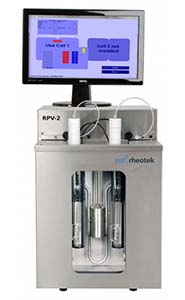
RPV-2 Automated Polymer Viscometer
RPV-2 Polymer Viscometer PSL-Rheotek
- Intrinsic Viscosity
- K-Value
- Limiting Viscosity
- Viscosity Number
- Inherent Viscosity
- Relative Viscosity
The PSL-Rheotek RPV-2 Polymer Viscometer is suitable for measuring the dilute solution viscosity of a wide range of polymers. Applications include PA, PET, PVC, PLA, PBT, PC, PE, PP, Cellulose Acetate, Inks, Biopolymers, Pulp and cellulose.
RPV-2 is designed for full integration with sample preparation and sample dissolution modules from PSL-Rheotek. Using these integrated options ensures full integrity of data from end to end in the measurement process.
Product Description
Polymer Viscosity
The PSL Rheotek RPV-2 polymer viscometer offers an all-inclusive package of technology for solution viscosity test work. Accurate control of the very low concentations employed in iv test work ensure high quality of test results. Automating the viscosity measurement work provides timely information for product specification and process control. K-value, viscosity number, relative viscosity results also available as per relevant test method.
With automation of flow time determination, results calculation, sample removal, sample path cleaning and sample path drying, the RPV-2 will save a lot of time in the polymer plant laboratory.
Full Method Compliance
Software configurations for all the most common test methods of solution viscosity are availabe as shelf products. So far, the following methods are covered: ASTM D4603, ISO 1628, part 1-5, ASTM D2857, ASTM D789, ISO 307. New methods are added on a continuous basis. An RPV-2 coded with correct method parameters and equations for calculations of results is a guarantee of full method compliance in the day to day testing work. The capillary tubes installed in teh unit are standard ASTM Ubbelohde.
Automated functions include:
- Sample push up
- Flow time determination
- Results calcuation
- Self-check of results quality
- Sample removal
- Sample path cleaning
- Sample path drying

